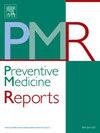以学校为基础的肥胖预防干预对6-18岁儿童健康行为的有效性:一项系统评价的二次数据分析
IF 2.4
3区 医学
Q2 PUBLIC, ENVIRONMENTAL & OCCUPATIONAL HEALTH
引用次数: 0
摘要
肥胖仍然是全球疾病负担的一个因素。不理想的饮食和缺乏身体活动是青少年肥胖的两个上升的危险因素;两者都是预防肥胖的目标。此外,这些风险行为聚集在一起,并可能与其他风险有关,包括吸烟和饮酒。然而,很少有研究调查针对肥胖的干预措施对其他健康行为的影响程度。本研究的目的是综合儿童肥胖预防计划对饮食、体育活动、吸烟和饮酒的影响,并调查针对不同行为的干预措施的不同效果。方法对已有的系统评价进行二次资料分析。文献检索确定了1990年至2023年与最初纳入的研究相关的任何其他论文。所有论文都经过筛选,如果报告了任何饮食、体育活动、吸烟或饮酒的结果,就符合条件。选择每个健康行为结局的结果。在可能的情况下进行meta分析以计算标准化平均差异。结果104项研究符合纳入标准。水果和蔬菜摄入量(标准化平均差(SMD) 0.104;95% (CI)(0.03, 0.17))和含糖饮料摄入量(SMD -0.126;95% CI(- 0.22, - 0.04)和体育活动均受到预防肥胖的积极影响(SMD为0.168;95% CI(0.05, 0.28))和久坐行为(SMD -0.021;95% ci(- 0.03, - 0.01))。吸烟和饮酒的结果好坏参半。结论与体重状况无关,学校肥胖预防计划可以改善儿童饮食摄入和身体活动的某些措施。研究注册:前瞻性注册:PROSPERO: CRD42021281106。本文章由计算机程序翻译,如有差异,请以英文原文为准。
The effectiveness of school-based obesity prevention interventions on the health behaviours of children aged 6–18 years: A secondary data analysis of a systematic review
Objectives
Obesity remains a contributor to the burden of disease globally. Suboptimal diet and physical inactivity are two rising risk factors of obesity in youth; both are targeted for obesity prevention. Further, these risk behaviours cluster and may be associated with other risks including smoking and alcohol intake. Few studies, however, have examined the extent to which interventions targeting obesity also impact on other health behaviours. The aim of this study is to synthesise the effects of child obesity prevention programs on diet, physical activity, tobacco smoking and alcohol intake, and to investigate differential effects by interventions that target different behaviours.
Methods
A secondary data analysis of an existing systematic review was conducted. Literature searches identified any additional papers from 1990 to 2023 associated with the originally included studies. All papers were screened and were eligible if they reported any diet, physical activity, smoking or alcohol outcomes. Results for each health behaviour outcome were selected. Meta-analysis was conducted where possible to calculate standardised mean differences.
Results
One hundred and four studies were eligible for inclusion. Fruit and vegetable intake (standardised mean difference (SMD) 0.104; 95 % (CI) (0.03, 0.17)), and sugar-sweetened beverage intake (SMD -0.126; 95 % CI (−0.22, −0.04)) were positively impacted by obesity prevention, as were physical activity (SMD 0.168; 95 % CI (0.05, 0.28)) and sedentary behaviour (SMD -0.021; 95 % CI (−0.03, −0.01)). Findings were mixed for tobacco smoking and alcohol intake.
Conclusion
Independent of weight status, school obesity prevention programs may improve some measures of child dietary intake and physical activity.
Study registration
Prospectively registered: PROSPERO: CRD42021281106.
求助全文
通过发布文献求助,成功后即可免费获取论文全文。
去求助
来源期刊

Preventive Medicine Reports
Medicine-Public Health, Environmental and Occupational Health
CiteScore
3.90
自引率
0.00%
发文量
353
 求助内容:
求助内容: 应助结果提醒方式:
应助结果提醒方式:


